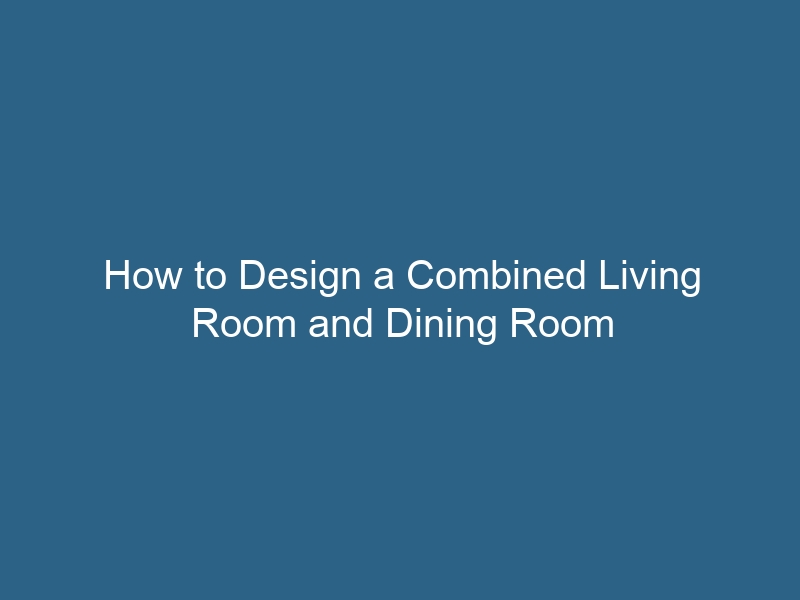Quck answer
When decorating a living room-dining room combo, it is important to create a cohesive and functional space. Start by defining separate areas using furniture placement and rugs. Choose a color scheme that flows seamlessly between both rooms and select furniture that complements each other. Use lighting to highlight different zones and create a cozy ambiance. Consider multipurpose furniture and storage solutions to maximize space. Incorporate artwork and decorative elements that tie the two rooms together. Finally, add personal touches and accessories to make the space feel inviting and reflective of your style. With careful planning and creativity, a living room-dining room combo can be a stylish and versatile space.
Just because a space is open plan doesn’t mean it will automatically be spacious, modern, and filled with light. In reality, it can be quite the opposite – cramped, shadowed, and awkward. The use and enjoyment of your living-dining space are heavily influenced by choices such as colors, textures, furniture scale, and storage. The first step is to analyze how you use both rooms and prioritize the space accordingly. It is important to create a connection and separation between the two halves of your room.
“Tiny” is an Understatement
Your combined living-dining room is smaller than a shoebox. As soon as you move a piece of furniture into it, you will find yourself constantly bumping into things. To make the most of this small space, think of it as a stage set. Place a bistro table and two chairs directly in front of the fireplace and surround the fireplace with floor-to-ceiling bookshelves. Hang a large framed piece of art over the mantel to emphasize the dining room area. Two identical wood stools or upholstered ottomans with hidden storage can be placed in front of the bookcases and used when needed. On the opposite wall, place a sofa or chaise with plump pillows on a large area rug. Add two matching chairs perpendicular to one end of the sofa to create an L-shape. Complete the seating arrangement with a clear acrylic trunk or a small coffee table in the corner.
Stick to a Limited Color Palette
Using monochrome and neutral colors can create a sense of calm in a busy combined living-dining room. However, this doesn’t mean you have to settle for a dull look. Opt for decorator-white walls and ceiling, a white sectional, white leather or upholstered dining chairs, white pendant lamps, and marble floors to bring the room together. Incorporate matte black elements such as a coffee table and dining table, furniture legs, and a contemporary black-and-white living room carpet to define the spaces. Use square shapes in black and white to further blend both areas. Choose cube-shaped club chairs upholstered in black to echo the square black frames around a grid of wall-mounted black-and-white art prints. The dining chair backs can be square-shaped, supported by black metal legs. To add an elegant touch, a narrow black border can be added to the top line of the windows wrapping around the corners of the room.
Expert Advice
Architectural Digest asked some of its favorite designers for their recommendations on designing a combined living room and dining room. Carleton Varney suggested using a Coromandel screen, green plants, and directed lighting to create a barrier between the two functional areas. Hugh Newell Jacobsen proposed dedicating two-thirds of the space to living room seating, with the back of the sofa against a refectory table of the same length. Chairs lined up along the far wall of the dining space can turn the long table into a banquet setting for guests. Ellie Cullman emphasized the importance of keeping colors and decor unified and defining the areas with two carpets. Mitchell Turnbough advised treating the dining area as a library, using the table as a library table, and pulling in chairs when needed for meals or company.
Camouflaged in Plain View
Invest in a wall unit that accommodates your collection of books, electronic devices, and flat screen television — and features a collapsible panel that can be transformed into a dining table for six. Decorate the room with vintage or high-quality reproductions of Mid-Century Modern furniture, such as a variety of vibrant molded fiberglass Eames chairs. These chairs serve as both functional seating and artistic elements — arranged around the couch and small coffee table, and neatly aligned against one wall when not in use. Simply pull the chairs up to the extended table for meals. The table can also double as a workspace, and the wall unit can include concealed cabinets for storing dinnerware and home office supplies.


